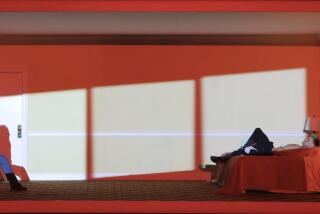Boys Town Is Booming but the Message Remains : One Man’s Dream for Unwanted Youngsters Now a Nebraska Landmark
- Share via
BOYS TOWN, Neb. — The year was 1921 when a bespectacled young Irish priest used his meager savings to buy a 160-acre farm outside Omaha.
After the final papers were signed on a crisp October morning, a group of homeless boys packed their scant belongings and headed 10 miles west of the city to their new home.
Theirs was a strangely moving procession. Two trucks loaded with worn furniture crept at the front. In their wake, under the expansive Nebraska skies, trudged 125 ill-clad youths pushing wheelbarrels and carrying suitcases. Along Dodge Street and past the city limits they plodded.
By sunset the scraggly paraders had bedded down in the “mecca of their dreams.” Overlook Farm had everything: rolling grasslands, barns, chicken coops, a cattle shed, even an ice house. No matter that they bunked in concrete-floored wooden barracks, heated by corncob-fed potbelly stoves.
These boys and their leader--the charismatic Father Edward J. Flanagan--were about to build a “City of Little Men.” Before long it would become, simply, Boys Town, the home for youths no one wanted.
Now, years later, Boys Town has become a tourist attraction.
In December, 1917, Father Flanagan had opened the doors of a large Omaha rooming house to his first wards: three newsboys and two boys living in the streets. Those were difficult days. The harried priest had to borrow $90 for the first rent. Three months later the house overflowed with 50 street kids.
Although Overlook Farm provided space to grow in, Father Flanagan remained in need of funds. In 1922 he organized a traveling minstrel show. Fifteen boys, billed as the “World’s Greatest Juvenile Entertainers,” toured Nebraska towns in four secondhand circus wagons. Wearing cutoff World War I uniforms, they sang their hearts out.
The Boys Town of today would almost certainly cause its emotional, soft-hearted founder to weep for joy.
A mini-metropolis stretching over 1,300 acres, it contains 98 buildings, including a post office, a dairy and horse farm, a greenhouse, a police department, a field house, an auditorium, schools and 70 living units--home to more than 500 troubled boys and girls who have been abused or neglected. Girls have been admitted to Boys Town since 1979.
A married couple, called “family teachers,” leads each home of six to eight youngsters aged 8 to 19. The youths cook, sew, do their own laundry, shop and plan menus, and learn social skills and how to communicate. Most stay about two years.
Now a National Historic Landmark, Boys Town has through the years provided shelter for more than 16,000 young people. It is one of Nebraska’s foremost tourist attractions, displaying its good work to about 100,000 visitors a year.
I find myself revisiting Boys Town almost like a retreat, seeking once again the farm’s simple serenity and sense of mission. The lovely landscape is permeated by a bucolic sense of peace.
Perhaps it is the abiding presence of Father Flanagan that makes the prairie air so radiant. Flanagan died of a heart attack in 1948 at age 62 while in Berlin on a mission for former President Harry S. Truman. He was seeking remedies for Europe’s displaced children.
Visitors stroll the priest’s former residence, explore the Hall of History museum, pause before the symbolic statue of a youth hoisting a small boy on his back, and stop at the Vocational Career Center, where 17 trades are taught.
On campus, the legendary Father Flanagan lived most of his adult years in a modest red-brick house with his sister Nellie. She was her brother’s personal adviser and surrogate mother, as well as a warm and giving homemaker to the boys.
The Flanagan house still retains its aura of warmth. Upstairs, Father Flanagan’s cassock, cape and white-laced surplice rest on his bed. In Nellie’s room, her wicker chair, sewing machine and personal items are arranged as if by Nellie herself.
In the study downstairs sits a six-foot inlaid desk of 39 types of wood. Boys from one of the manual training classes made the desk for Father Flanagan. They began the tedious task of fitting together thousands of pieces of wood in 1936, taking three years to complete.
Les Dreifuerst, former youth counselor and longtime guide at Father Flanagan’s residence, remembers the man whose dream is now a legacy.
“The father was full of life,” Dreifuerst recalls. “Typically Irish, he flared up if kids got into mischief, especially the big ones. But with little guys, he was a bleeding heart.”
The spirit of the young people who have lived in the home is mostly alive in the Hall of History museum. In the foyer, newspaper headlines dramatically describe the plight of unwanted children in the early 1900s: “Children Living With Pigs,” “Boy Tramps Found Worthless Lot,” “Parent Would Pawn Boy and Girl for $300.”
Against this attention-getting backdrop, a lifesize figure of Father Flanagan stands with an arm around the shoulders of a boy wearing tattered pants and a raggedy sweater.
In the museum, exhibits depict scores of people associated with the City of Little Men, from President Truman and actor Mickey Rooney to comic strip characters Joe Palooka and Captain Marvel.
An attraction is the Academy Award won by Spencer Tracy for his portrayal of Father Flanagan in the 1938 movie, “Boys Town.” After the film was completed, it was shelved for several months, with Louis B. Mayer, MGM president, insisting, “It will never sell, there’s no sex!”
Visitors also will see scenes from “Boys Town,” as well as from two other motion pictures about Boys Town. In addition, home movies about campus life in the early 1960s are shown.
Throughout the Hall of History, moving mannequin displays tell the story of Father Flanagan and his boys. One display depicts a runaway boy sleeping in a cardboard storage box; pressing a nearby button elicits the story of Billy’s life in the streets.
Another display shows three early Overlook Farm boys shooting marbles, one of the few leisure activities the priest could afford for his tatterdemalion brigade in the early years. He once sadly said: “Some of the finest people in the world go through life handicapped because they never learned how to play as children.”
The museum’s crimson circus wagon is a reminder of those first minstrel shows and boy soprano voices.
Also on exhibit is the front half of the old school bus that used to carry Boys Town football teams to games. By entering and honking the horn, you can start a film of the football games. In the 1940s, Boys Town football teams rolled over opponents across the country.
Museum displays also introduce today’s family living program. “My Room” is an exhibit showing a typical corner of a young resident’s room: a desk, a closet full of clothes and a bureau with a mirror. Look into the mirror. You see yourself. But the mirror “talks” at the push of a button above it. Alternating girls’ and boys’ voices tell their stories:
“This is my room at Boys Town. I didn’t always live here, but my parents used to fight a lot and sometimes they hit me. I’ve run away. In my room I study and pray and take care of my clothes and work on projects I like to do. Sometimes I get lonely. We come from places like your hometown and your neighborhood. We could even be you.”
A Hall of History tour ends quietly with a brief videotaped message from the current director, Father Val Peter, quoting from Father Flanagan: “The work will continue, you see, whether I am there or not, because it is God’s work, not mine.”
A fitting end to a Boys Town visit is the Dowd Memorial Chapel and Father Flanagan Shrine, where a marble and bronze vault contains the beloved priest’s tomb. Embossed on the tomb are the Irish leader’s most famous words: “There are no bad boys. There is only bad environment, bad training, bad example, bad thinking.”
Boys Town is about 10 miles west of Omaha on U.S. 6 (Dodge Street). A visit should begin at the Visitors Center, which, along with the Hall of History and Father Flanagan’s residences, is open daily from 8:30 a.m. to 4:30 p.m., except Thanksgiving, Christmas, New Year’s Day and Good Friday afternoon. Dowd Memorial Chapel is open daily.
Self-conducted tours of Boys Town can be taken all year. The Visitors Center has maps and tape recordings explaining what to do and see on campus.
Personally guided tours by Boys Town teen-agers are available hourly from the Visitors Center in June, July and August, between 9 a.m. and 3 p.m. All Boys Town attractions, including tours, are free.
Points of interest include the Music Hall, which houses band and choir practice rooms; the Boys Town High School and Wegner Middle School; the Field House, which has a trophy case near the entrance; the Roe Garden, adjacent to the Father Flanagan House, plus the Vocational Career Center, Dairy Farm and Hall of History.
The Boys Town choir sings on Sunday at the Dowd Chapel 10:30 a.m. mass. There are also masses at 8 a.m. and 9:15 a.m. Protestant services begin at 9:15 a.m. at the Nativity Chapel.
The Visitors Center has a cafeteria (open Monday through Friday, 11 a.m. to 1:30 p.m.), souvenirs and a display of stamps and coins. The most unusual item is a 600-pound solid ball of stamps that has been featured in Ripley’s Believe It or Not. The ball is 32 inches in diameter and consists of 4,655,000 used stamps. Nine boys constructed it in 1974. It took them nine months.
For more information on Boys Town, write to Father Flanagan’s Boys Home, Boys Town, Neb. 68010, or call the Visitors Center at (402) 498-1140.
More to Read
Sign up for Essential California
The most important California stories and recommendations in your inbox every morning.
You may occasionally receive promotional content from the Los Angeles Times.













